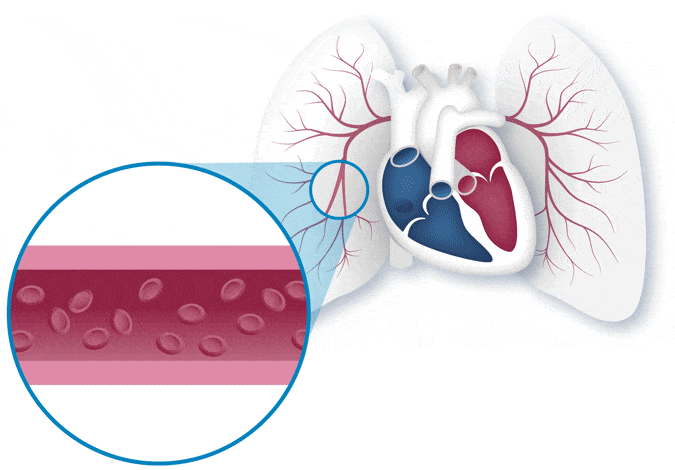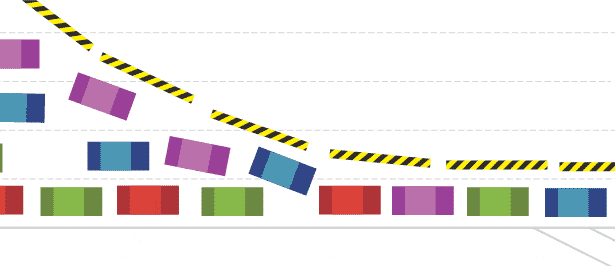What is PAH, anyway?
PAH isn’t just high blood pressure. PAH is…- The medical abbreviation (acronym) that stands for pulmonary arterial hypertension
- A certain kind of high blood pressure in the lungs that specifically affects the way your heart and lungs work together
- A condition that causes blood vessels in the lungs to become narrower, which means the heart must work harder to push blood through these tighter passages

How does PAH cause slower “traffic” in your blood vessels?
Imagine your blood vessels as the highway. Your blood cells are like the cars. When blood vessels in the lungs become narrow, it reduces the flow of blood cells—similar to the way traffic flow slows down when lanes are closed.

Learn how this “traffic jam” in the lungs causes changes in the heart and how treatment can help open these “closed lanes.”
PAH Effects on Heart & LungsWhy does PAH, a lung disease, affect the heart?
When you have PAH, the blood vessels in your lungs thicken and become narrow, making your heart work harder to pump blood through them.
PAH begins when the walls of the blood vessels in the lungs thicken and become more narrow. Because the blood vessels become more narrow, it’s harder for the blood to pass through them. The reduced blood flow that is caused by the narrowed vessels creates increased pressure on the right side of the heart. The right side of the heart tries to compensate by working harder to pump blood through the vessels and into the lungs. Over time, the heart struggles to maintain this level of intensity. It’s like asking your heart to run a marathon every minute of every day and PAH symptoms result.
How serious is PAH, and what kind of doctor should I see?
PAH is a progressive disease, meaning it gets worse over time and can eventually be fatal.
While all PAH is serious, some doctors may describe your PAH differently depending on how PAH is affecting you or how your PAH may progress. You may have heard terms like “mild,” “moderate,” or “severe” to describe how PAH affects an individual.
Learn more about how PAH specialists think about PAH severity today and what can be done about it.
PAH Life ExpectancyPatient perspective: Working with a PAH specialist
Why is it important to see a PAH specialist?
Because PAH is a serious disease that is life threatening, finding a healthcare provider who specializes in treating PAH is extremely important. Not all cardiologists and pulmonologists have expertise treating PAH. A PAH specialist has extensive training and experience in diagnosing and treating PAH, so they may be more knowledgeable about the latest treatment advances and options.
For some, finding and getting to a PAH specialist can be a challenge. You may not know where to begin your search. The Pulmonary Hypertension Association (PHA) offers a finder tool to help you get started.
Find a PAH Specialist[On Screen Text: Working with a PAH Expert. PAH Initiative - Sponsored by United Therapeutics - Committed to Improving the Lives of Patients.]
[On Screen Text: Karen PAH Initiative Ambassador]
It was a shock to have this diagnosis.
[On Screen Text: Joanne PAH Initiative Ambassador]
I learned very quickly after my diagnosis, that it was very, very important to see someone who specializes in pulmonary arterial hypertension.
[On Screen Text: Laura PAH Initiative Ambassador]
It's all confusing at first, it's scary and confusing.
I have seen in my support group, folks who want to stick to a doctor, maybe a local doctor that they know.
[On Screen Text: Denise PAH Initiative Ambassador]
This disease is so rare that every doctor may not know about it.
Even though you're comfortable with that doctor, it's important to find someone who specializes in this field because that person is going to have all of the knowledge that you are going to need.
I really think that you need to see a PAH specialist because a PAH specialist is going to have a lot more dedicated knowledge to the PAH world.
I would encourage others to go ahead and do their homework on this disease.
I walk in every appointment, I have my notes, I have my questions already written down.
I'm fighting for my life, and so when I'm in the doctor's office, I have to be selfish.
I fully take the lead and I will tell the doctor how I'm doing or what I've been doing.
Some doctors are great with helping you connect with support groups or helping you connect with someone who does have PAH.
If I have a question, I can call the main nurse of the department and they'll call me back within a day.
We have an app through the hospital. We communicate through email a lot, and we also have Facebook friends with my nurse. So, we are able to communicate in a lot of different ways nowadays.
And I have been incredibly fortunate to be under their care.
[On Screen Text: PAH Initiative - Sponsored by United Therapeutics - Committed to Improving the Lives of Patients. For more resources about PAH, please visit www.PAHInitiative.com]
Learn more about PAH
Keep asking questions! The more you know about your PAH, the better equipped you will be to fight it.
Why does someone get PAH?
What Causes PAH?What are the symptoms of PAH?
Symptoms of PAHHow is PAH diagnosed?
PAH Diagnosis & Testing